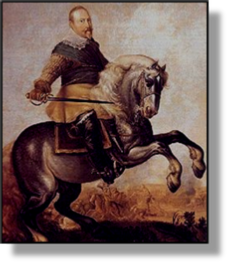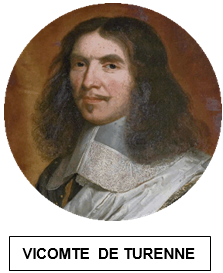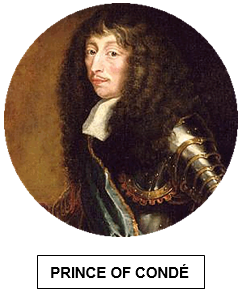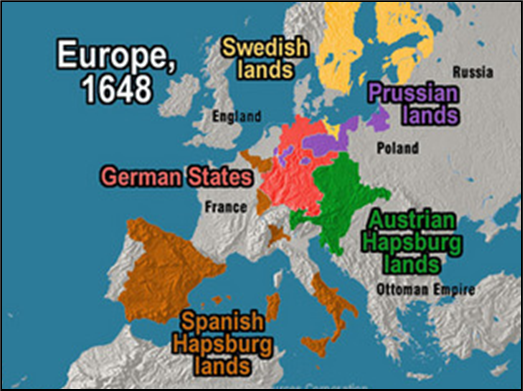


xxxxxAs we have seen, the intervention of Gustavus Adolphus of Sweden in 1630 in support of the Protestant cause eventually proved unsuccessful. The Swedes agreed to a peace settlement in 1635. It was in this year, however, that Roman Catholic France, whose leader Richelieu was more concerned with politics than religion, entered the war to cut the Roman Catholic Habsburgs down to size. Over the next ten years, France, with her allies Sweden and the United Provinces, slowly wore down the imperial forces and, following the defeat of an Austro-
THE THIRTY YEARS' WAR
FRANCE DECLARES WAR ON SPAIN 1635 -
Acknowledgements
Adolphus: 17th century, artist and location unknown. Turenne: detail, 17th century portrait, artist unknown – contained in Historical Essays on the City of Étampes by Maxime de Montrond (1805-
 xxxxxAs we have seen, the intervention of Gustavus Adolphus of Sweden in 1630 (illustrated), like the earlier one led by Christian IV of Denmark and Norway, was unsuccessful both in protecting the Protestant faith in northern Germany and in restricting the political power of the Habsburgs. The Swedish king had met with early success, but with his death at the Battle of Lutzen in 1632 the Swedes had lost their charismatic leader. His successor, Duke Bernhard, took some ground, but in September 1634 he was comprehensively defeated by imperial forces at the Battle of Nordlingen, and the Peace of Prague was signed the following year.
xxxxxAs we have seen, the intervention of Gustavus Adolphus of Sweden in 1630 (illustrated), like the earlier one led by Christian IV of Denmark and Norway, was unsuccessful both in protecting the Protestant faith in northern Germany and in restricting the political power of the Habsburgs. The Swedish king had met with early success, but with his death at the Battle of Lutzen in 1632 the Swedes had lost their charismatic leader. His successor, Duke Bernhard, took some ground, but in September 1634 he was comprehensively defeated by imperial forces at the Battle of Nordlingen, and the Peace of Prague was signed the following year.
xxxxxIt was in this year, however, (1635), that the war -
 xxxxxOver the next ten years, this powerful albeit strange alliance was to prove too much for the war weary imperial forces. From the very beginning, the Habsburg position in Germany was seriously undermined by two Swedish victories, one at Wittstock in October 1636 and the other at Rheinfelden in March 1638. Slowly but surely the imperial troops were obliged to fall back from their strongholds in northern Europe, while Swedish forces swept over Austria and western German
xxxxxOver the next ten years, this powerful albeit strange alliance was to prove too much for the war weary imperial forces. From the very beginning, the Habsburg position in Germany was seriously undermined by two Swedish victories, one at Wittstock in October 1636 and the other at Rheinfelden in March 1638. Slowly but surely the imperial troops were obliged to fall back from their strongholds in northern Europe, while Swedish forces swept over Austria and western German y, and occupied a Denmark which had chosen to side with the Empire. Meanwhile in the west, Spanish invasions of France were repulsed and in 1640 Portugal rebelled against their Catholic masters and gained independence under their own monarchy. In the Netherlands too, the Dutch were coming close to victory in their 80-
y, and occupied a Denmark which had chosen to side with the Empire. Meanwhile in the west, Spanish invasions of France were repulsed and in 1640 Portugal rebelled against their Catholic masters and gained independence under their own monarchy. In the Netherlands too, the Dutch were coming close to victory in their 80-
xxxxxThexdecisive battle took place in August 1645 with the defeat of an Austro- convincing victory at the Battle of Lens in August 1648, that Emperor Ferdinand, fearing an attack upon Vienna, agreed to a settlement. As we shall see, by the Peace of Westphalia in the October (1648), peace was concluded between France, Sweden, the German princes and the Holy Roman emperor.
convincing victory at the Battle of Lens in August 1648, that Emperor Ferdinand, fearing an attack upon Vienna, agreed to a settlement. As we shall see, by the Peace of Westphalia in the October (1648), peace was concluded between France, Sweden, the German princes and the Holy Roman emperor.
xxxxxThe bloody and destructive Thirty Years' War, beginning in 1618, was at an end, but not all the fighting ceased. As we shall see, the war between France and Spain rumbled on until 1659 (CW), and it was not until the following year that the Swedish conflict with Poland and Denmark was eventually concluded by peace settlements.
xxxxxIncidentally, just five years after the end of the Thirty Years’ War the able French general the Duc d’Enghein -
C1-


